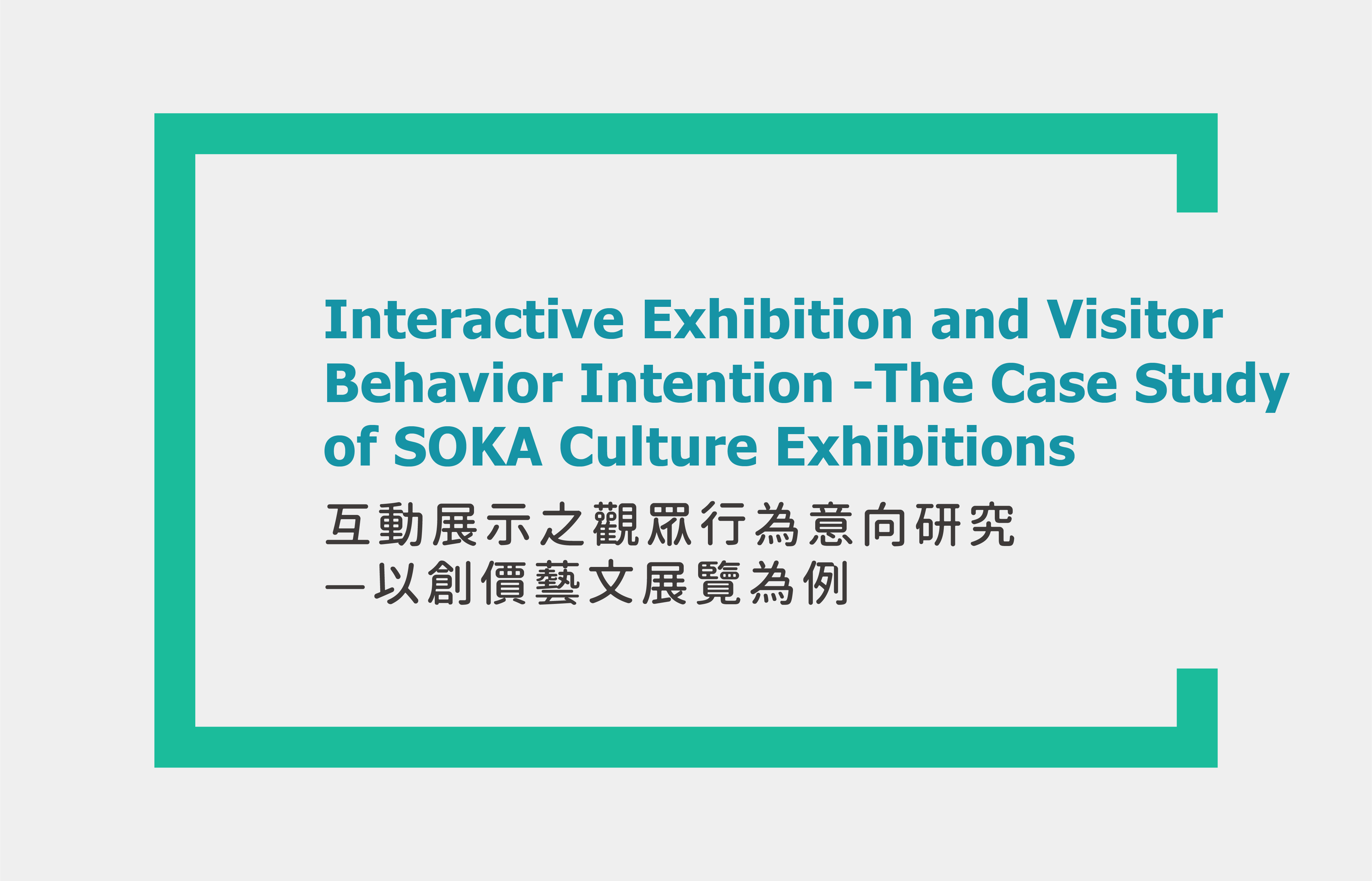互動展示之觀眾行為意向研究—以創價藝文展覽為例
Interactive Exhibition and Visitor Behavior Intention -The Case Study of SOKA Culture Exhibitions
中文摘要
本研究探互動展示的觀眾參與經驗,應用總體學習成果模式(Generic Learning Outcomes, GLOs)理論,探討觀眾參與動機與總體學習成果。此研究以創價藝文的觀眾為對象。創價藝文自2003年起,以「文化尋根‧建構美術百年史」為策展主軸,推出以不同媒材創作的藝術家個展,展覽超過120位台灣在地藝術家。但究竟觀眾的參與經驗成效為何?是否有藉由互動展示的設置達成學習經驗的提升?
本研究選擇以創價藝文的〈大化衍行 陳庭詩的藝術天地〉藝術家系列展覽為主要研究對象,在於瞭解創價藝文為觀眾族群,試圖在策展上以「觀眾體驗」的方式,評估不同展覽中的教育互動區體驗,希望能藉此讓民眾在互動中學習的方式認識展覽中的美學知識內容。該系列展覽旨在促進並評估參觀者接觸本土藝術文化的新方式,藉此了解藝術作品的內涵與價值以提升學習成效。透過總體學習成果模式(Generic Learning Outcomes, GLOs)綜合選出評量指標,提出拓展接觸藝術的新方式,也建立起評估學習經驗影響力的方法,進而達成評估設計展區之目的。研究方法包含調查研究,以到藝文中心觀展的觀眾作為研究對象,透過問卷調查蒐集資料,進行統計分析;而透過訪談策展團隊,藉此建立質量並重的展示評估。此研究可進行不同面向的展示分析,並可針對記憶性議題而對資料做更深入的分析,希望能探求在未來提供策展上的教育互動學習成效的關鍵因素。
Abstract
This study explores the audience participation experience and applies the Generic Learning Outcomes (GLOs) theory to explore audience participation motivation and overall learning outcomes. This study is aimed at viewers of the price-based art. Since 2003, Soka Culture has set up a solo exhibition of artists with different media materials with the theme of “Searching for the Root of Culture-Constructing the Centennial History of Taiwanese Art”. It has more than 120 Taiwanese artists. But what is the effectiveness of the audience's participation experience? Is there an improvement in learning experience through interactive display settings?
This study chooses the artist series exhibition of "Grand Transformations Spread Forth- Chen Ting-Shih’s Artistic World" as the main research object of the price-based art. It is to understand the price-generating art as the audience and try to use the "visitors experience" in the curatorial process. Evaluate the experience of the educational interactive area in different exhibitions, hoping to let the people know the aesthetic knowledge content in the exhibition in the way of learning in the interaction. The series aims to promote and evaluate new ways for visitors to come into contact with local art and culture, so as to understand the connotation and value of art works to enhance learning outcomes. Through the Generic Learning Outcomes (GLOs), the selection indicators are comprehensively selected, and new ways to expand the art of contact are proposed. The method of assessing the influence of learning experience is also established, and the purpose of evaluating the design exhibition area is reached. The research method includes investigation and research, and the audience of the exhibition in the Art and Culture Center is used as the research object. The questionnaires are used to collect data for statistical analysis. Through the interviewing and curating team, the quality assessment is emphasized. This research allows for different orientation-oriented presentation analysis and a more in-depth analysis of data for memory issues, hoping to explore key factors in the future of curatorial interactive learning.
參考文獻
Engel, J. F., Blackwell, R. D. and Miniard, P. W. (1995). Consumer Behavior(8th ed. ). Forth Worth: Dryden.
Folkes, V. S.(1988). Recent Attribution Research in Consumer Behavior: A Review and New Directions. Journal of Consumer Research, 14, 548-565.
Kennedy, J. (1990). User friendly: Hands-on exhibits that work. Washington, D.C.: Association of Science- Technology Centers.
Loomis, R. 1993. Planning for the Visitor: The Challenge of Visitor Studies. In S. Bicknell & G. Farmelo (eds.), Museum Visitor Studies in the 90s. pp. 13∼23. London: Science Museum.
McLean, K.(2001)。如何為民眾規劃博物館的展覽(Planning for people in Museum exhibition)(徐純譯)。屏東:國立海洋生物博物館。(原作1993年出版)
Parasuraman, A., Zeithaml, V. A., and Berry, L. L.(1996). The Behavioral Consequence of service Quality. Journal of Marketing, 60, 31-46.
Schmitt, B, J.(1999)Experiential Marketing, Journal of Marketing Management 15, 53-67.
Schmitt, Bernd(1999),Experiential Marketing: how to get customers to sense, feel, think, act and relate to your company and brands, New York : Free Press.
王啟祥(2004)。國內博物館觀眾研究知多少Museum Visitor Study in Taiwan。博物館學季刊,頁95-104。
吳明敏(2009)。體驗行銷、體驗價值與行為意向之相關研究。真理大學休閒遊憩事學系碩士論文,新北市。
吳青蓉(2017)。創價藝文的行動美術績效研究~行銷策略觀點。文藻外語大學國際事業暨文化交流研究所碩士學位論文。
吳春秀(1996)。博物館觀眾研究—以故宮博物館玉器陳列室為例,碩士論文,國立臺灣師範大學社會教育學系,台北。
吳紹群(2014)。博物館多媒體互動展之海外展覽觀眾滿意度研究。博物館學季刊,頁93-120。
李栴滌(2005)。美術館觀眾研究:以高雄市立美術館為例。國立臺南藝術大學 博物館學研究所碩士論文。
李新源(2016)。國立海洋科技博物館遊客體驗價值與行為意向之研究。國立屏東大學生態休閒教育教學碩士學位學程碩士論文,屏東縣。
林千秋(2017)。親子觀眾博物館參觀動機與總體學習成果之研究。國立臺灣師範大學美術學系碩士論文,台北市。
林宜君(2003)。太魯閣國家公園兒童環境教育館觀眾行為研究。國立東華大學觀光暨遊憩管理研究所碩士論文。
洪楚源編譯,James Bell原著(1997)。互動式展示的規劃。博物館學季刊。
國立臺灣藝術教育館(2017)。藝術教育貢獻獎,績優團體/財團法人創價文教基金會。取自:http://web.arte.gov.tw/aecp/content02_show.aspx?page=3&cid=6
張崇山(2009)。博物館互動式展示之思與辨。科技博物,頁5-16。
許博超(1994)。博物館觀眾研究的評鑑類型與原則。國立臺灣師範大學美術研 究所碩士論文。
陳信廷(2010)。以體驗行銷觀點—探討數位看板於博物館之應用與發展。國立臺灣大學管理學院商學研究所碩士論文。
創價藝文(2018)。「博物館的社會行動特展」簡介,https://goo.gl/MEsTPy
創價藝文(2018)。「關於我們」簡介,http://www.sokaculture.org.tw/
童欣儀(2014)。體驗行銷、顧客滿意度及行為意向之研究—以國立自然科學博物館為例。國立臺中教育大學教育學系教育行政與管理碩士在職專班論文。
黃世輝(1991)。博物館展示記號的設計、傳達與認知。國立科學博物館籌備處展示組八十年度研究計畫報告,頁35-36。
黃世輝、吳瑞楓(1992)。展示設計,臺北市 : 三民書局股份有限公司,頁275-276。
賈明蓉(2017)。探討博物館觀眾學習成效研究:以國立臺灣科學教育館科學演示活動為例。國立臺北教育大學文化創意產業經營學系碩士論文,台北市。
劉建明(2016)。體驗行銷、服務品質對遊客滿意度與重遊意願之影響—以黃金博物館為例。中國科技大學企業管理系碩士在職專班碩士學位論文。
劉婉珍(2008)。觀眾研究與博物館的營運發展。博物館學季刊,頁4-17。
劉婉珍(2011)。博物館觀眾研究。台北市:三民書局股份有限公司,頁1-2。
蔡寶元(2010)。體驗行銷策略研究—以國立歷史博物館特展為例。國立政治大學商學院經營管理碩士學程(AMBA)青年領袖班碩士學位論文。
盧昭蓉(2003)。博物館運用“體驗行銷”(Experiential Marketing)策略之研究-以國立科學工藝博物館之“塑膠與橡膠”廳為例,科技博物,頁3-22。
